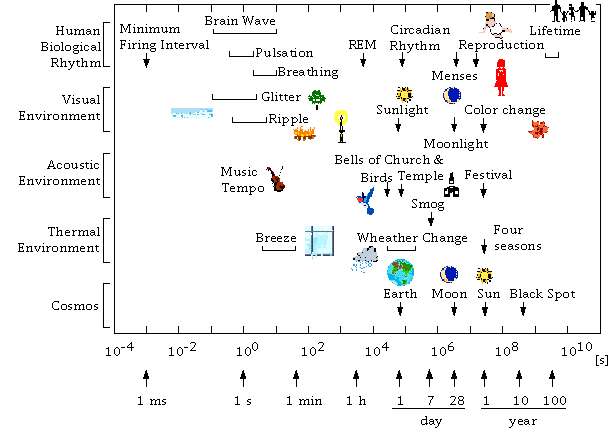

The crucial factor in the temporal dimension of the environment is the periodic cycle. Every aspect of the passage of time is bound up with periods: For example, the shortest period (about 0.5 - 5 s) corresponding to the "psychological present" is related to brain wave, pulsation and breathing which are associated with perception of music, the glitter of leaves and the ripple of water surface. The rapid eye movement (REM) of about 70 - 150 minutes, related to a basic rest-activity cycle of 10 to 20/day [1, 2], is associated with, for example, one session of a concert, lecture and work. The circadian rhythm deeply connected by sunlight with the earthÕs rotation period is associated with daily human activity. The week created by the social law for work and leisure is associated with, for example, the planning period of concert and drama, or social activity. The next distinguishable period is concerned with the movement of the moon. The revolution of the earth around the sun (changing of the seasons) is associated with, for example, the color change of leaves and the annual festival. The black spots on the sun appears every about 11 years may have influenced on more or less environment on earth. Such a periodic space weather including the magnetic storm may cause effects on human life [3]. The alternation of generation of about 30 years and the span of life of, say, about 90 years, may be considered in the planning of houses according to the individual schedule of life.
These discrete periods should be explicitly recognized during the design process for any human environment. The passage of time in the designed environment should be as consciously considered as the three-dimensional organization of the space itself.
[1] E. Othmer, M.P. Hayden and R. Segelbaum (1969). Encephalic cycles during sleep and wakefulness in humans: A 24-hour pattern. Science, 164, 447-449.
[2] D.F. Kripke (1972). An ultradian biologic rhythm associated with perceptual deprivationand REM sleep. Psychosomatic Medicine, 34, 221-234.
[3] J.G. Roederer (1995). Are magnetic storms hazardous to your health? Eos. Trans. Amer: Geophys. Union, 76, 444-445.